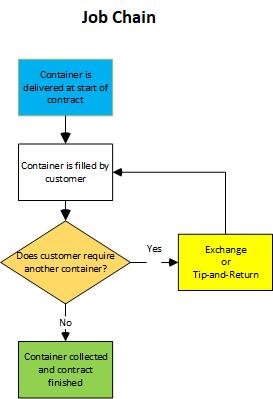When a customer orders a waste collection service, it will comprise of the delivery of a container (skip or bin) which the customer will fill in one of two ways:
- The container is filled whilst the vehicle waits on site. In this case the ‘container’ may be either a skip, a bin or the cargo section of a vehicle (tipper, dumper, man-and-van, etc). This job type is known as Wait-and-Load.
- The container is dropped off and filled by the customer over a pre-agreed period of time.
In case 1 above, the job is a single event as far as Skiptrak and the customer are concerned, but in the more usual case 2, a ‘Job Chain’ is created.
The length of the chain will depend on the customer’s requirement, but will always start with a ‘Delivery’ and end with a ‘Collection’. In between these two emdpoints will be any number (from 0 upwards) of ‘Exchange’ or ‘Tip-and-Return’ events (see flow diagram below).

It is important to bear in mind this flow of a job-chain when initially commencing and then developing an ongoing contract, as Skiptrak is able to ‘keep track’ of the whole job chain from ‘Delivery’ to final ‘Collection’, no matter how many intermediate ‘Exchange’ or ‘Tip-and-Return’ events occur within the chain. Skiptrak enables you to trace backwards or forwards through each job in the sequence.


Post your comment on this topic.